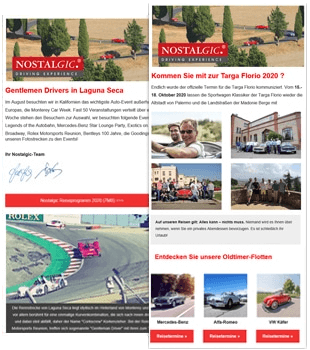
The brand will be 110 years old with one of the most beautiful emblems in the world, the green Visconti dragon and the red cross on a white background of the city of Milan. 110 years full of emotions and passion, marked by grandiose victories and bitter defeats, outstanding technical achievements and disastrous mismanagement. Again and again on the verge of ruin, icons of automotive engineering were created despite or precisely because of this.
Kaum war 1910 mit dem Alfa 24 HP das erste Auto auf dem Markt, schlitterte die junge Firma in den Ersten Weltkrieg und die erste Insolvenz. Nach der Übernahme durch die Investoren rund um Ingenieur Nicola Romeo gab es die finanziellen Mittel, um erfolgreich bei den damals ins Leben gerufenen Automobilrennen zu starten. Internationale Aufmerksamkeit bescherte Ugo Sivocci’s Sieg bei der Targa Florio 1923, danach folgte eine fast ununterbrochene Siegesserie bei großen Rennen, allen voran 11 erste Plätze bei der Mille Miglia, dazu Grand-Prix-Siege im In- und Ausland. Konstrukteure wie Giuseppe Merosi and Vittorio Jano, Rennleiter wie Enzo Ferrari, Fahrer wie Tazio Nuvolari, Antonio Ascari and Rudolf Caracciola zementierten den Nimbus Alfa Romeo als den eines Automobilherstellers, der Autos baut, welche Rennen gewinnen – und von vermögenden Privatfahrern für den Alltag gekauft werden können.

Als nach dem Krieg die Formel 1 gegründet wird, dominieren die leichten Alfa Romeo Rennwagen („Alfetta 159“) über Jahre die Grand-Prix-Strecken, bevor sich das Management des mittlerweile verstaatlichten Autobauers unvermittelt und für lange Zeit aus der Königsklasse des Rennsports verabschiedet.

Die sportlichen Gene der Marke und die erfolgreiche Rennhistorie der ersten vier Jahrzehnte müssen herhalten, um eine jüngere Käuferschaft anzusprechen und die Stückzahlen nach oben zu schrauben. Unter dem neuen Chef Giuseppe Luraghi und seinen Cheftechnikern Orazio Satta Puliga und Giuseppe Busso entstehen die Traum-Alfa Romeo’s aus der Glanzzeit der Marke. Auch in Italien sind es die „goldenen“ 1950er Jahre, die Wirtschaft boomt, und die Alfa Romeo Giulietta als Limousine, Coupé und Spider werden das Vorzeigemodell all derer, die es geschafft haben.

1959 verkauft Alfa Romeo in nur einem Jahr so viele Stückzahlen wie in der gesamten Firmengeschichte bis dahin, knapp 30.000 Einheiten. Während 1960 nördlich der Alpen Daimler-Benz kurz davorsteht, den taumelnden Münchner Autobauer zu übernehmen, rollen in Arese bei Mailand die Bagger für das modernste Automobilwerk Europas. Zwei Jahre später eröffnet Alfa Romeo sein Werk in der Heimatstadt nicht ahnend, daß nur wenige Jahre später mit den 1968er Revolten und den Arbeiterkämpfen die schwersten Jahre beginnen.

Der Einfluß der Politik nimmt zu, unter vorgehaltener Hand erzählen sich die Mailänder, welche Partei wie viele Arbeitsplätze im florierenden Staatsunternehmen erhält. Nachweislich werden arbeitslose Bäckergehilfinnen in die Lackiererei vermittelt, ungelernte Hilfskräfte in die technischen Büros, Analphabeten in einen Anzug gesteckt und als Fahrer angeheuert. Der „assenteismo“, die unbegründete Abwesenheit vom Arbeitsplatz, klettert in Rekordhöhe, die Produktivität fällt ins Bodenlose. Die mittlerweile ausgegründete Rennabteilung Auto Delta feiert gleichzeitig fulminante Siege auf Straßen- und Bergrennen, Sportwagenikonen wie die leichten Alfa Romeo Sprint GTA (Gran Turismo Allegerita – zu Deutsch „Leichtbau-GT“) und die Alfa 33 Boliden zeigen ihren Konkurrenten nur die Rückleuchten.

Es sind die Jahre, in denen Alfa Romeo Vertragshändler eigene Teams unterhalten und an den Start gehen lassen. Zu den italienweit erfolgreichsten Niederlassungen gehörte die Alfa-Vertretung in Siena, die 1968 einen jungen Mann ins Rennen schickt, der es in kürzester Zeit vom Lehrling zum Chefmechaniker bringen sollte: Amerigo „Joe“ Bigliazzi saß am Wochenende im Cockpit, an den Werktagen schraubte er an Kunden- und Rennwagen. Der drahtige junggebliebene Italiener startete in einem Alter, in dem andere ans Aufhören denken, noch einmal durch und gründete seine eigene Werkstatt vornehmlich für Oldtimerkunden – für Nostalgic ein Grund, die Alfa Romeo Flotte von Anfang an in Siena zu stationieren.
Nach 75 Jahren Herzblut und Leidenschaft verliert Alfa Romeo 1985 seine Eigenständigkeit und wird Teil der damaligen Fiat-Gruppe, heute FCA Automobiles. Die neuen Eigentümer bemühen sich, die Historie der Marke nicht in Vergessenheit geraten zu lassen und bringen spannende Modelle wie den Alfa Romeo 8C und den kleinen Bruder Alfa Romeo 4C auf den Markt, die ihre sportlichen Gene nicht verleugnen können. 2018 erfolgte dann der Start in der Königsklasse des Automobilsports - der Formel 1.

Sie interessieren sich für die Geschichte des italienischen Sportwagenbaus? Dann haben wir eine spannende Reise zur Wiege des italienischen Sportwagenbaus für Sie im Programm. Sie fahren 4 Tage am Steuer eines Alfa Romeo Spider aus den Glanzzeiten von Alfa Romeo durch die Emilia Romagna, besuchen die Casa Enzo Ferrari und die Galleria Ferrari in Maranello u.v.m.. Klicken Sie hier für Detailinformationen zu der Nostalgic Reise in die Emilia Romagna.
Balanstraße 73 / 81541 München
Office: +49 (0)89 5454060
Fax: +49 (0)89 5454066
E-mail: info@nostalgic.de

Register for the Nostalgic Newsletter

Join over 5000 other Classic Car fans!
Subscribe to the free newsletter now and be inspired!